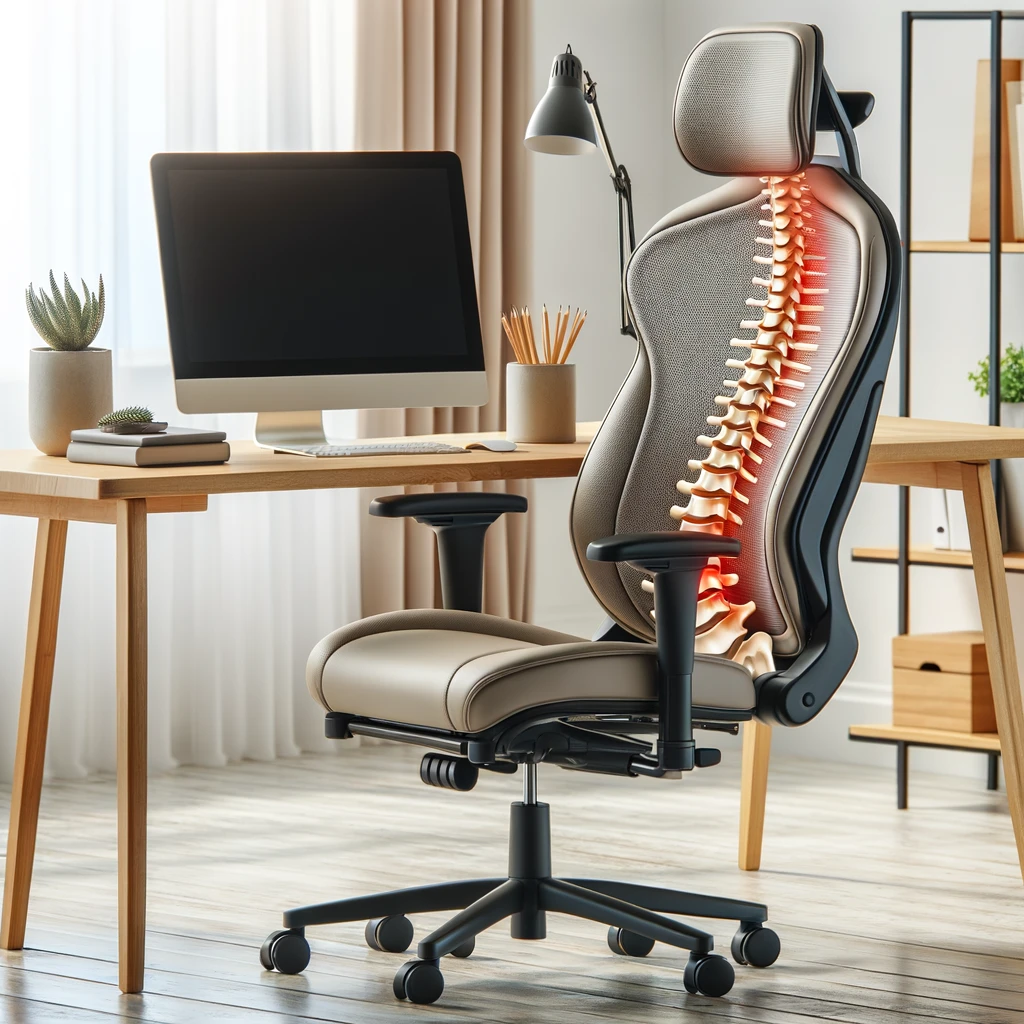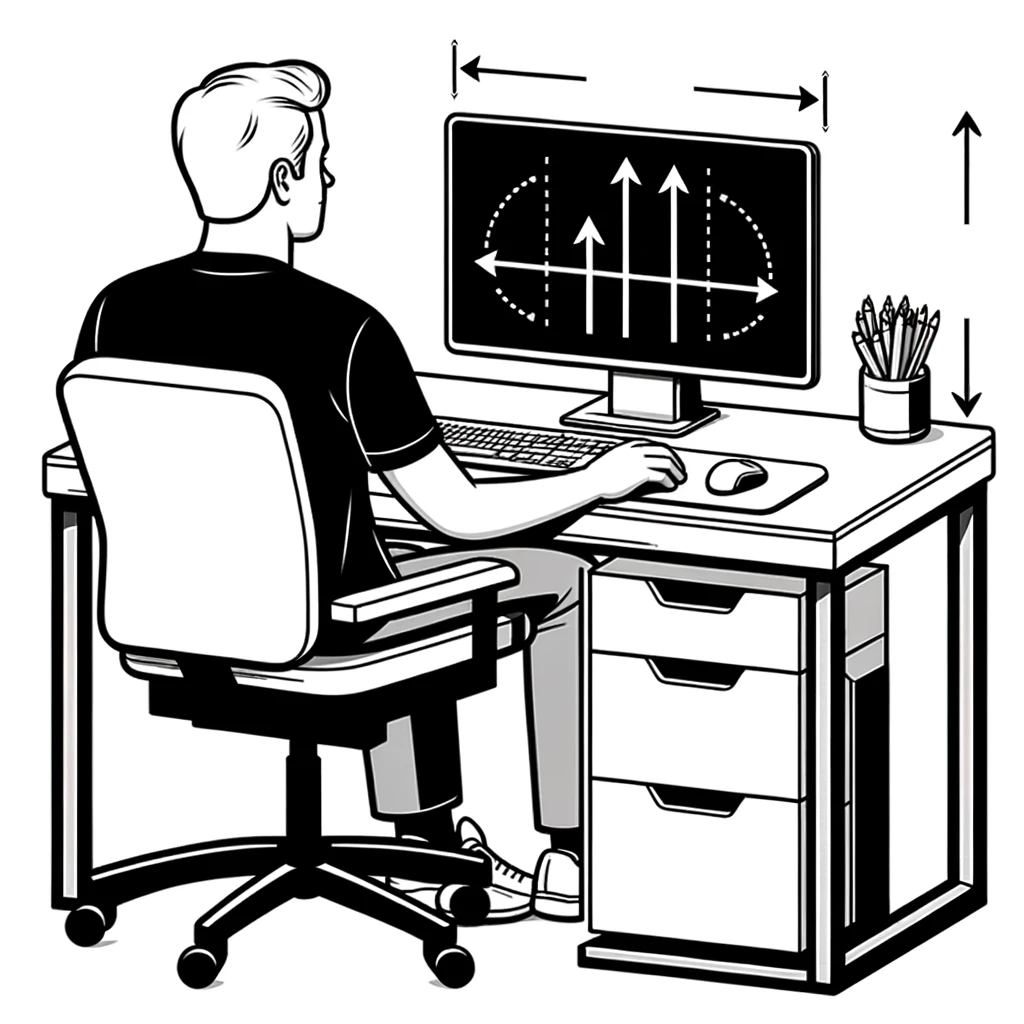Reading time: 9 minutes.
In the modern work environment, where many of us spend hours at our desks, the importance of setting up an ergonomic workspace cannot be overstated. Ergonomics, the science that deals with designing and arranging things people use so that the people and things interact most efficiently and safely, plays a pivotal role in our daily work life. It’s not just about comfort; it’s about preventing strain and injury that can arise from poorly designed workspaces. An ergonomic workspace aims to tailor the work environment to fit the individual’s needs, rather than forcing the individual to adapt to the workspace. This approach not only enhances overall well-being but also boosts productivity and efficiency.

In this guide, we will delve into the essential elements of an ergonomic workspace. From choosing the right furniture to positioning equipment and adopting healthy work habits, each aspect plays a significant role in creating a workspace that promotes comfort, reduces the risk of injury, and improves work performance. Whether you’re setting up a new office or revamping your current space, these insights will help you create an ergonomic environment that meets your work needs and supports your physical health.
Understanding the Basics of Ergonomics
Before diving into the specifics of setting up an ergonomic workspace, it’s essential to understand what ergonomics entails. Ergonomics involves designing or arranging workplaces, products, and systems so that they fit the people who use them. The goal is to create a workspace that allows you to work in a natural, comfortable position, reducing strain on your body.
The Importance of Ergonomics
Ignoring ergonomic principles can lead to a range of problems, such as back pain, neck pain, eye strain, and repetitive strain injuries like carpal tunnel syndrome. These issues can lead to decreased productivity, increased absenteeism, and even long-term health problems.
The Ideal Ergonomic Workspace Setup
Setting up an ergonomic workspace involves considering various elements, including your chair, desk, computer, keyboard, mouse, and the overall environment.
1. Ergonomic Chair

An ergonomic chair is one of the most critical components of your workspace. It should support your lower back (lumbar region), have adjustable seat height, armrests, and a backrest that supports the natural curve of your spine. Your feet should rest flat on the floor, with your knees at a 90-degree angle.
Key Features of an Ergonomic Chair:
- Adjustable height
- Lumbar support
- Adjustable backrest
- Breathable fabric
- Swivel base for easy movement
2. Desk Considerations
Your desk should accommodate your work needs while allowing you to maintain a comfortable position.
Tips for an Ergonomic Desk:
- Ensure the desk height allows your elbows to be at a 90-degree angle when typing.
- Consider a standing desk or an adjustable desk to alternate between sitting and standing.
- Keep frequently used items within easy reach to minimize stretching or straining.
3. Computer Monitor Setup
The placement of your computer monitor can significantly impact your neck and eye strain.
Guidelines for Monitor Setup:
- Position the monitor about an arm’s length away.
- The top of the screen should be at or slightly below eye level.
- Use an adjustable monitor stand if necessary.
- Consider an anti-glare screen if you experience eye strain.
4. Keyboard and Mouse Placement
Your keyboard and mouse should be positioned to keep your wrists in a neutral position.
Ergonomic Tips for Keyboard and Mouse:
- Use a keyboard tray to adjust the height and angle.
- Keep your mouse close to the keyboard to avoid overreaching.
- Consider ergonomic keyboard and mouse designs that promote natural wrist posture.
5. Lighting and Environment
Proper lighting and a comfortable environment are crucial in an ergonomic workspace.
Enhancing Your Workspace Environment:
- Ensure adequate lighting to reduce eye strain. Natural light is ideal, but if not possible, use a combination of general and task lighting.
- Minimize glare by positioning screens away from direct light sources.
- Maintain a comfortable room temperature and consider air quality – plants can improve air quality and add a calming element to your workspace.
6. Taking Breaks and Movement
Regular breaks and movement are essential parts of an ergonomic approach to work.
Importance of Breaks and Movement:
- Take short breaks every hour to stretch and move around.
- Use break time to rest your eyes, reducing the risk of eye strain.
- Consider desk exercises or a standing desk to incorporate movement into your workday.
Personalizing Your Ergonomic Workspace

While there are general guidelines for setting up an ergonomic workspace, it’s important to tailor these to your individual needs. Body size, the nature of your work, and personal preferences play a significant role in determining the best ergonomic setup for you.
Customizing Your Setup:
- Adjust your chair, desk, and monitor to suit your height and sitting style.
- Choose accessories like wrist rests or footrests based on your personal comfort.
- Experiment with different setups to find what feels most natural and comfortable.
Common Ergonomic Mistakes to Avoid
As you set up your ergonomic workspace, be mindful of common mistakes that can undermine your efforts.
Mistakes to Watch Out For:
- Using a chair without adequate lumbar support.
- Placing the monitor too high or too low, leading to neck strain.
- Keeping the keyboard or mouse too far away, causing shoulder and arm strain.
- Poor lighting that leads to eye strain.
Tips for Maintaining an Ergonomic Posture
Maintaining an ergonomic posture is essential for your overall well-being, especially when spending long hours at a desk. Here are some tips to help you keep a good posture:
- Align Your Body: Ensure your head is in line with your shoulders and your back. Avoid slouching or leaning forward. Your ears should align with your shoulders.
- Adjust Your Chair: Use a chair that provides proper lower back support. Adjust the height so your feet rest flat on the floor, and your knees are in line with your hips.
- Monitor Position: Position your monitor at eye level and about an arm’s length away. This prevents you from tilting your head up or down, which can strain your neck.
- Keyboard and Mouse Placement: Place your keyboard and mouse within easy reach. Your elbows should be at a 90-degree angle, and your wrists should be straight while typing or using the mouse.
- Take Regular Breaks: Stand up, stretch, or walk for a few minutes every hour. This helps to relieve muscle tension and improve circulation.
- Mindful Seating: Be aware of your posture throughout the day. Adjust as needed to avoid staying in the same position for too long.
Remember, maintaining an ergonomic posture is not just about equipment placement but also about being aware of your body and making small adjustments regularly. By following these tips, you can help reduce the risk of discomfort and long-term injury.

Essential Components of an Ergonomic Workspace
An ergonomic workspace involves several key components, including furniture, equipment positioning, and work habits. Let’s delve into each of these areas.
1. Ergonomic Furniture
a. Chair:
An ergonomic chair should support your spinal curves, have adjustable seat height, and provide adequate cushioning. Your feet should rest flat on the floor or on a footrest, and your thighs should be parallel to the floor.
b. Desk:
Choose a desk that can accommodate your height and working style. A sit-stand desk is a great option to encourage movement throughout the day.
2. Computer and Accessories Positioning
a. Monitor:
Position your monitor about an arm’s length away, with the top of the screen at or slightly below eye level. This positioning helps reduce eye strain and encourages good posture.
b. Keyboard and Mouse:
Place your keyboard and mouse within easy reach. Your wrists should be straight, and your upper arms close to your body to prevent strain.
c. Laptop Use:
If you use a laptop, consider a laptop stand, external keyboard, and mouse to maintain an ergonomic posture.
3. Lighting and Environment
a. Lighting:
Ensure your workspace is well-lit, with lighting sources that reduce glare and eye strain. Natural light is beneficial, but if it’s not available, use a combination of general and task lighting.
b. Noise:
Minimize noise distractions as much as possible. Consider noise-cancelling headphones if you work in a noisy environment.
4. Work Habits
a. Taking Breaks:
Take short breaks every hour to stretch and move around. This helps reduce muscle fatigue and eye strain.

b. Posture:
Be mindful of your posture throughout the day. Avoid slouching or leaning forward from your chair.
Step-by-Step Guide to Setting Up Your Ergonomic Workspace
Now that we’ve covered the essentials, let’s go through the steps to set up your workspace ergonomically.
Step 1: Adjust Your Chair
Adjust your chair so that your feet are flat on the floor or on a footrest. Your knees should be at a 90-degree angle, and there should be a small gap between the back of your knees and the front of the seat. The backrest should support your lower back.
Step 2: Position Your Desk
If you have an adjustable desk, set it to a height that allows your arms to be parallel to the floor when typing. If you have a sit-stand desk, alternate between sitting and standing throughout the day.
Step 3: Set Up Your Monitor
Place your monitor at an arm’s length away, with the top of the screen at or slightly below eye level. If you wear bifocals, lower the monitor to a comfortable reading level.
Step 4: Arrange Keyboard and Mouse
Position your keyboard and mouse close to each other and within easy reach. Your wrists should remain straight while typing or using the mouse.
Step 5: Optimize Lighting and Environment
Arrange your workspace to utilize natural light without causing glare on your screen. Supplement with additional lighting if necessary. Organize your workspace to minimize noise distractions.
Step 6: Develop Healthy Work Habits
Remember to take breaks, stretch, and change positions frequently. Be mindful of your posture and make adjustments as needed throughout the day.

Advanced Ergonomic Tips
To further enhance your workspace ergonomics, consider the following tips:
1. Monitor Arms and Stands
Using monitor arms or stands can help you achieve the optimal position for your screen, especially if you use multiple monitors.
2. Ergonomic Accessories
Consider ergonomic accessories like keyboard trays, wrist rests, or footrests to provide additional support and comfort.
3. Workspace Layout
Organize your workspace so that frequently used items are within easy reach. This minimizes unnecessary stretching or twisting.
4. Eye Care
Practice the 20-20-20 rule: every 20 minutes, look at something 20 feet away for at least 20 seconds to reduce eye strain.
5. Mindfulness and Body Awareness
Regularly check in with your body throughout the day. Be aware of any discomfort or strain and make adjustments as needed.
Conclusion
Creating an ergonomic workspace is an investment in your health, well-being, and productivity. As we’ve explored, it involves more than just selecting the right furniture; it’s about creating a holistic environment that supports your physical and mental health while you work. Remember, ergonomics is a dynamic process. It requires regular assessment and adjustment to ensure that your workspace continues to meet your evolving needs. Don’t hesitate to modify your setup as you discover what works best for you.
Furthermore, the benefits of an ergonomic workspace extend beyond the immediate physical comfort. By reducing strain and the risk of injury, you’re likely to experience enhanced focus, increased productivity, and overall job satisfaction. In essence, a well-designed ergonomic workspace is a key component of a sustainable work life. Embrace these principles and enjoy a healthier, more comfortable, and more productive work life.





